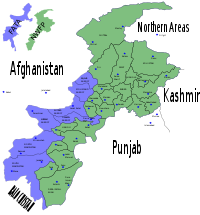Operation Sirat-e-Mustaqeem
| Operation Sirat-e-Mustaqeem | |||||||
|---|---|---|---|---|---|---|---|
| Part of the Insurgency in Khyber Pakhtunkhwa | |||||||
 | |||||||
| |||||||
| Belligerents | |||||||
|
|
| ||||||
| Commanders and leaders | |||||||
|
|
| ||||||
| Units involved | |||||||
|
| ||||||
| Strength | |||||||
| Unknown | Unknown | ||||||
| Casualties and losses | |||||||
| 1 soldier killed | 2 militants killed | ||||||
The Operation Sirat-e-Mustaqeem (English: Operation Righteous Path), was a Pakistan Army operation in Bara Tehsil of Khyber Agency, Federally Administered Tribal Areas. The operation was commenced on June 28, 2008, and was halted by the Army on July 9, 2008, after liberating Bara Tehsil from the terrorist.[7] On July 9, 2008 another operation, codenamed Zarbe-Kaleem, was launched in Hangu district.[8]
Khyber Operation
[edit]The Operation Sirat-e-Mustaqeem (English: Operation Righteous Path) was launched by Pakistan Army's 40th Infantry Division. Prime minister Yousaf Raza Gillani's government had ordered the Pakistan Army to launch an operation against the Taliban forces in the tribal district of Khyber Agency. According to the Prime minister, the operation was aimed at the Mangal Bagh, a Taliban commander, and was launched as last resort.[7]
The 40th Infantry Division carried out aggressive military campaigns against Tehreek-e-Taliban Lashkar-e-Islam and its rival, Ansarul Islam. The troops were forwarded to Bara Tehsil of Khyber Agency where LeI headquarters were located.[9]
The immediate trigger for the operation was two incidents of kidnapping which occurred in Peshawar on the June 21, 2008. Militants abducted six women from the city's posh Hatband neighborhood on allegations of involvement in human trafficking, and a group of 16 Christians, including two priests, was abducted in broad daylight during a prayer meeting. The Christians were released following hurried negotiations between the government and Islamist groups in the region.[10] Both kidnappings were perpetrated by the Islamist group Lashkar-e-Islam, which was the target of Operation Sirat-e-Mustaqeem in Khyber Agency.[7]
During the weeks of fighting, the 40th Infantry Division had taken control of a key town and demolished the LeI's military infrastructure. During the operation, two militants were reported to be killed while one soldier was also killed in operation. The military had removed the elements of the LeI organization. As result of the operation, Pakistan was able to secure government control in Khyber.[1]
References
[edit]- ^ a b Alexander Mikaberidze (31 July 2011). "Conflict and Conquest in the Islamic World: A Historical Encyclopedia, Volume 1". ABC-CLIO. ISBN 9781598843361. Archived from the original on 18 September 2021. Retrieved 31 July 2011.
- ^ Abbas, Hassan. “Reforming Pakistan's Police and Law Enforcement Infrastructure.” United States Institute of Peace, 2011, pp. 13. This report discusses Operation Sirat-e-Mustaqeem as successful in disrupting militant networks in Khyber Agency in 2008.
- ^ Fair, C. Christine. “The Militant Challenge in Pakistan.” Asia Policy, no. 11, 2011, pp. 110. doi:10.1353/asp.2011.0010. This journal article analyzes Pakistan's counterinsurgency operations, including the gains made in Operation Sirat-e-Mustaqeem in 2008.
- ^ Javaid, Umbreen, and Musarat Javed. “Pakistan’s Fight against Terrorism.” Defense & Security Analysis, vol. 32, no. 1, 2016, pp. 56. doi:10.1080/14751798.2015.1127155. This article provides an overview of Pakistan's counterterrorism operations, referencing success in Operation Sirat-e-Mustaqeem against militants.
- ^ Khan, Ismail. "Pakistan’s Offensive Against the Taliban." CTC Sentinel 2.6 (2009): 2. Web. This journal article mentions the 2008 Sirat-e-Mustaqeem operation driving militants from Khyber.
- ^ Yusuf, Moeed. “Conflict Dynamics in Pakistan.” United States Institute of Peace, 2 Oct. 2012, p. 4. This report analyzes conflict in Pakistan, noting Operation Sirat-e-Mustaqeem as a significant 2008 counterinsurgency victory.
- ^ a b c "Defence Day of Pakistan—fresh blood infused". The News. Archived from the original on 24 October 2017. Retrieved 6 September 2017.
- ^ "Killing the hydra-headed monster of militancy". Express Tribune. Archived from the original on 9 June 2012. Retrieved 9 May 2010.
- ^ "Ultimatum given to militants".
- ^ "Militants Abduct Christians During Prayer Meeting in Peshawar". Archived from the original on 2011-07-16. Retrieved 2011-01-11.
